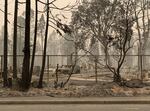
Destruction after the Almeda Fire in Phoenix, Oregon.
Erik Neumann
In September, the Almeda Fire left unprecedented destruction in the Southern Oregon towns of Phoenix and Talent. While wildfires are nothing new here, the level of urban destruction was striking. And it offers lessons about future fire risks to communities in Oregon.
Four months since the fire, scores of homes, trailers and commercial buildings lay in jumbles of burned metal and charred concrete adjacent to Talent Avenue.
“This is my home town. It’s really hard to see this,” said climate scientist Dominick DellaSala. “These were homes that I had dined in before with friends. Totally annihilated.”
DellaSala is with the environmental nonprofit Wild Heritage. His house didn’t burn down in the Sept. 8 fire, but he did evacuate. Now as he watches property being cleared and wooden houses rebuilt, he worries nothing will change as Talent is reconstructed in the face of increasing wildfire risks.
“We’re just going to do the same thing. It’s like the definition of crazy,” he said. “You do the same thing over and expect a different outcome. We saw that in Santa Rosa and I hope we don’t see it here again.”
The Almeda fire destroyed more than 2,600 homes and businesses, including whole subdivisions and trailer parks in Talent and Phoenix. Forest fires are a natural part of the landscape in Oregon, but in recent years this type of urban destruction has been more common in places like California’s wine country or further south.
“I used to carry around with me pictures of devastating fires in Southern California so that I could convince people that such a thing is possible and show them examples of where communities were devastated,” said Chris Chambers, the wildfire division chief at Ashland Fire and Rescue, where he’s worked for the past 18 years. “Then I’ve watched over that time as those fires have marched northward.”
Firefighters refer to the patchwork landscape where houses and forests blend together as the “wildland-urban interface.” These days, fires are burning in areas that weren’t traditionally considered wildlands. That change is stretching our definition of what the wildland-urban interface is, according to Erica Fleishman, director of the Oregon Climate Change Research Institute and a professor of earth, ocean and atmospheric sciences at Oregon State University.
“These aren’t little towns in the woods, when you drive through the woods and you see some really cute little houses with a lot of trees around them and brush around them and think ‘this may not end well,’” " Fleishman said. “This is a different type of situation.”
Fleishman said a big reason there are more intense fires today is because there is more fuel that can burn. Warming temperatures means more precipitation will fall as rain instead of snow.
“Basically, you have evaporation increasing. So, for the same amount of precipitation, it goes away faster. And plants have less ability to use it over a long period of time,” she said.
As plants dry out, more fuel is created that can burn in forests. But the same dynamics apply to trees in urban areas, like the sliver of woodlands between Ashland and Talent, called the Bear Creek Greenway, where the Almeda Fire started.
Chris Chambers with Ashland Fire and Rescue said the climate change predictions for Oregon are that three to four times more acres will burn in the coming decades than today. Along with that increase in fire will come an increase in smoke.
“To see three times more than what we’ve experienced, even here, is really hard to imagine for most people, including me,” Chambers said. “But, nonetheless, that’s the prediction for Southwest Oregon.”
Chambers, Fleishman and DellaSala agree that the risk to Oregon communities is getting higher. Chambers said it’s impossible for firefighters to stop blazes like the Almeda fire because of the dry conditions and the way it was propelled by 40-mile-per-hour winds.
Looking forward, he said, everyone in the Rogue Valley needs to know how to evacuate quickly. Existing homes need to incorporate basic defensible space principles, like removing surrounding wood bark that could act as ignition and cleaning out flammable material in gutters. And, he said, new construction needs fire-resistant building codes.
In Talent, DellaSala is working with a contractor to design homes made with fire-resistant materials like concrete and steel, instead of wood.
He hopes community members will rebuild Talent to avoid another disaster like the Almeda Fire, and to recalculate their ideas of risk to meet today’s reality.
“This is our new reality and it changes everything,” DellaSala said. “We’ve got to do things differently about how we design communities, how we build homes, where we build homes, because this isn’t going away.”